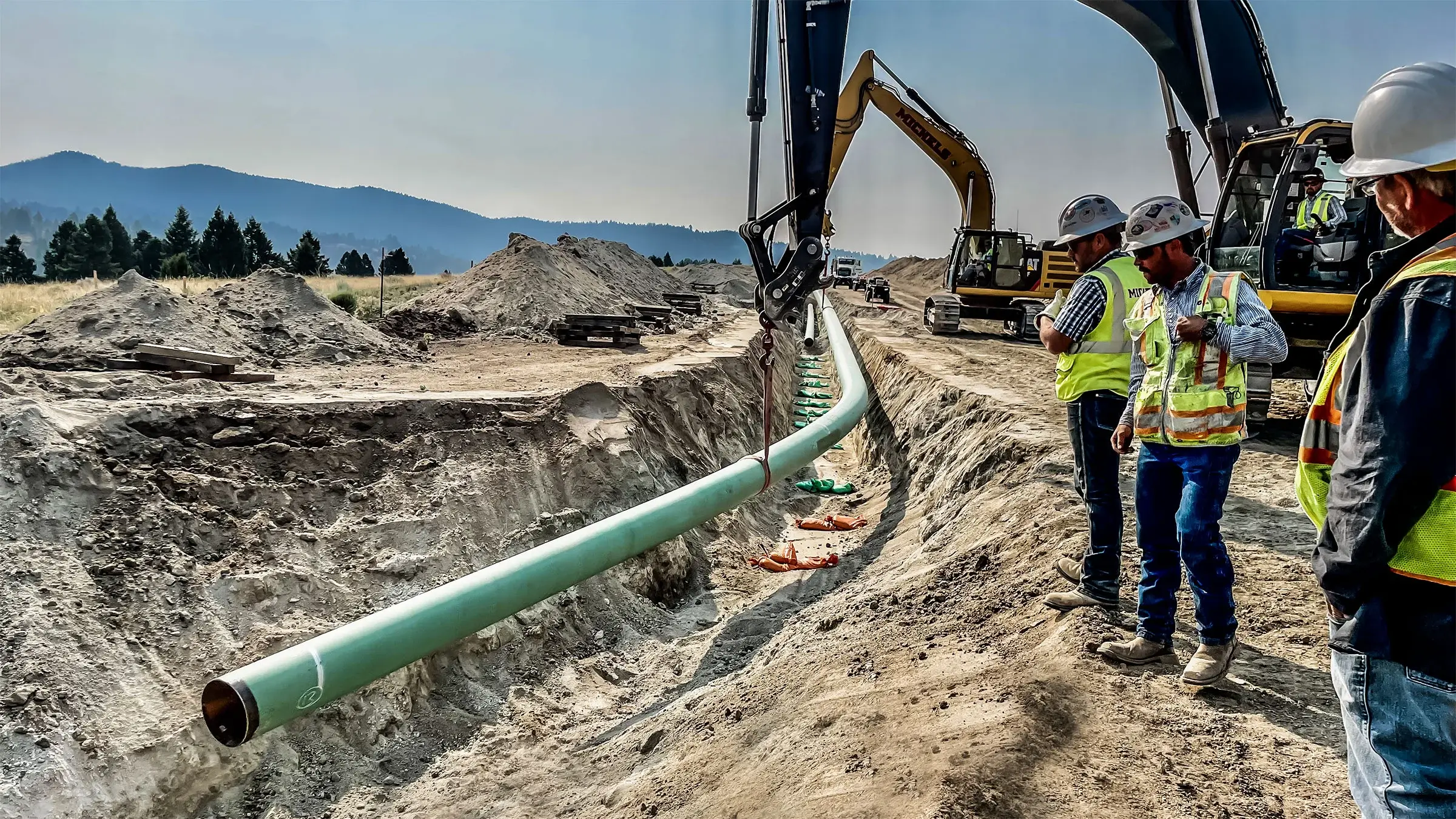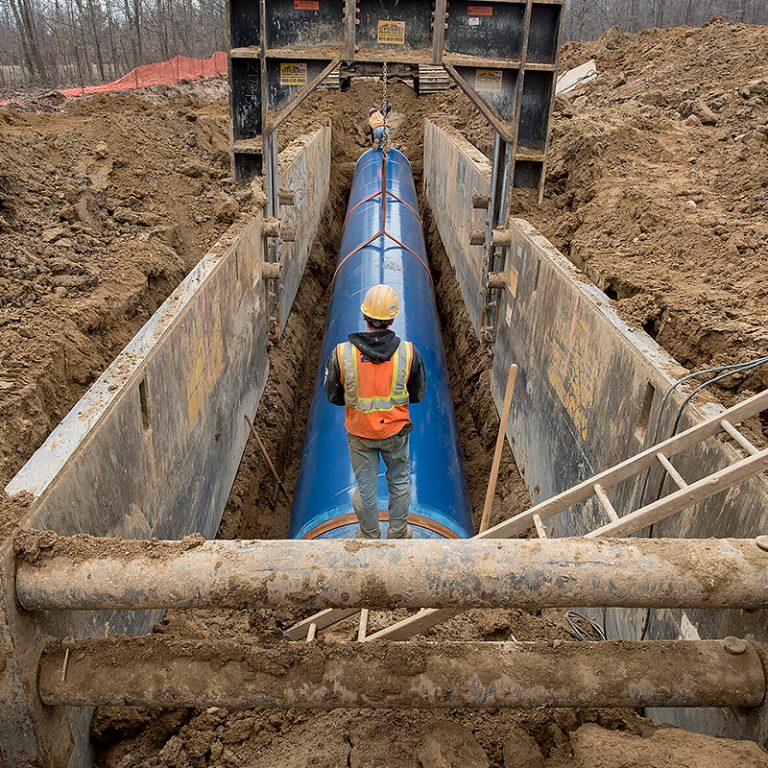Common Questions Answered About Working With Creek Pipe Company
The Significance of Pipeline Construction: Exploring the Services Used in the Industry
Pipeline construction is an important component of modern facilities. It helps with the transportation of necessary resources like oil, gas, and water. The market encompasses numerous services, consisting of planning, website prep work, and installation. Each stage requires precision and adherence to safety criteria. As areas depend on these systems for their resources, understanding the ins and outs of pipe construction exposes its relevance and potential challenges. What elements affect the success of these projects?
Overview of Pipeline Construction Solutions
Pipeline construction services incorporate a series of specialized tasks designed to help with the installation of pipes for transferring different compounds, consisting of oil, gas, and water. These services usually include site prep work, excavation, installation of pipeline sectors, and backfilling. Experienced labor and innovative devices are essential for assuring each stage is implemented with accuracy and safety.Safety protocols are critical, as these tasks frequently involve collaborating with harmful materials and in difficult atmospheres. Quality control steps identify that the pipes meet industry requirements and regulations. In addition, the services might include trenchless innovation, which lessens surface disruption.Environmental considerations play a substantial function in pipeline construction, needing assessments and reductions to shield surrounding ecosystems. In general, pipeline construction solutions are necessary for establishing the framework necessary for power and water circulation, sustaining both economic growth and societal needs.
Preparation and Layout in Pipeline Projects
Reliable preparation and style are vital components of effective pipeline projects, guaranteeing that all aspects are carefully dealt with prior to construction starts. This phase entails thorough feasibility researches that examine the technical, economic, and environmental variables influencing the project. Engineers and designers team up to produce thorough plans that outline the pipe path, products, and construction methods, straightening with governing needs and sector standards.Advanced software program and modeling strategies are often employed to imitate numerous scenarios, maximizing the design for effectiveness and safety. Ecological effect analyses are performed to mitigate potential harm to environments and neighborhoods, mirroring a commitment to lasting techniques. In addition, stakeholder engagement is necessary, cultivating communication and attending to problems from impacted celebrations. Ultimately, efficient planning and style established the structure for a pipeline project, minimizing risks and making certain a streamlined construction process, inevitably adding to the total success of the procedure.
Site Prep Work and Excavation
Complete website prep work and excavation are crucial action in the pipe construction process. This phase includes an in-depth evaluation of the land where the pipeline will certainly be set up. Task teams perform studies to determine dirt kinds, topography, and existing energy lines to ensure a secure and efficient excavation. Appropriate site preparation reduces environmental impact and assists in smoother construction operations.Excavation complies with, where heavy machinery is used to eliminate dirt and rock, creating a trench that meets the defined deepness and size for the pipeline. This process needs to abide by safety and security laws and environmental guidelines to avoid damage to surrounding ecosystems.Additionally, disintegration control measures are applied to maintain the website throughout and after excavation. Effective site prep work and excavation add greatly to the total success of pipe projects, laying a solid foundation for the subsequent phases of construction.
Pipeline Installation Methods
Pipeline installation techniques are necessary for the effective implementation of facilities projects. 2 noticeable methods consist of trenchless innovation, which minimizes surface interruption, and the open-cut excavation procedure, known for its simple method. Each method supplies unique benefits and considerations depending on job demands and ecological variables.
Trenchless Technology Methods
While standard techniques of pipe installment commonly include extensive excavation, trenchless modern technology techniques supply a more efficient and eco friendly alternative. These ingenious methods, such as straight directional boring and pipeline bursting, reduce surface area interruption by enabling the installation of pipelines without comprehensive digging. This not only minimizes the ecological influence but also significantly lowers labor and repair prices. Trenchless techniques assist in the installment of pipelines in metropolitan locations where standard excavation would be impractical or harmful to existing facilities. Furthermore, these methods can accommodate different soil kinds and problems, making them functional remedies for pipeline construction. Ultimately, trenchless technology stands for a significant improvement in the pipeline sector, advertising sustainability and operational performance.

Open-Cut Excavation Process
Open-cut excavation remains a fundamental method in pipeline setup, characterized by the direct excavation of a trench to lay pipes. This technique includes removing soil and other materials to produce a trench of sufficient deepness and size, permitting the placement of pipelines at the called for quality. Open-cut excavation is typically liked for its cost-effectiveness and simplicity, specifically in locations with stable dirt problems. Nonetheless, it can disrupt surface tasks and calls for cautious planning to manage web traffic and ecological effects. Security steps have to be executed to protect workers and close-by framework during the excavation process. Overall, while open-cut excavation may not appropriate for all terrains, it continues to be a commonly made use of technique in pipe construction.
Evaluating and Quality Control
Evaluating and high quality guarantee are essential elements in pipeline construction, guaranteeing that installments meet well established security criteria and performance demands. Various assessment techniques and techniques are employed to evaluate material high quality and adherence to regulative compliance. This systematic method aids determine prospective problems before they intensify, protecting the stability of the pipeline system.

Inspection Techniques and Methods
Assessment methods and approaches are important parts in making certain the honesty and safety and security of pipeline construction. Various strategies, consisting of visual inspections, ultrasonic testing, and radiographic exams, are employed to find issues and validate quality. Visual inspections enable the recognition of surface anomalies, while ultrasonic screening makes use of audio waves to evaluate wall surface thickness and situate flaws internally. Radiographic assessments entail X-rays or gamma rays to create pictures of the pipe's framework, exposing surprise issues. In addition, pressure testing is performed to review the pipe's honesty under functional conditions. These approaches collectively add to a thorough understanding of the pipe's condition, enabling timely upkeep decisions and making sure compliance with sector criteria. Effective examination is essential for avoiding failures and advertising lasting functional safety.
Safety And Security Standards Conformity
Making sure compliance with safety and security standards is critical in pipeline construction, as it directly influences the task's general high quality and reliability. Following well-known policies and guidelines warranties that construction techniques reduce threats connected with pipe setup and procedure. Creek Pipe Company. Rigorous testing protocols, including non-destructive testing and stress assessments, are vital in confirming that pipes can withstand the functional tensions they will certainly encounter. Quality sites control steps are additionally essential, as they establish a structure for constant tracking and assessment throughout the construction process. By focusing on safety criteria conformity, business not just secure employees and the atmosphere but additionally enhance the integrity of the pipe, eventually leading to long-lasting operational success and public rely on the framework
Product High Quality Examination
Product high quality examination plays a significant role in the overall honesty of pipe construction. This procedure includes extensive screening and top quality guarantee procedures to ensure that materials meet sector requirements and specs. Various tests, including tensile strength, corrosion resistance, and weld stability evaluations, are carried out to recognize any kind of prospective weaknesses. A detailed evaluation not just ensures the efficiency of the pipeline yet likewise improves safety and security and toughness over its lifespan. Additionally, implementing read more quality assurance protocols assists reduce risks connected with material failings, which can lead to expensive fixings and environmental threats. By prioritizing material quality analysis, firms can assure conformity with governing requirements while promoting confidence amongst stakeholders in the reliability of their pipe systems.
Repair And Maintenance Providers
Upkeep and repair service services play a crucial function in the long life and efficiency of pipe systems. These services encompass regular examinations, troubleshooting, and rehabilitative activities to attend to damage, leaks, and various other problems that may develop gradually. Knowledgeable specialists use innovative technologies such as ultrasonic testing and wise pigging to check pipe integrity, ensuring that any type of prospective issues are identified early.Additionally, maintenance programs usually consist of set up precautionary procedures developed to boost system reliability and reduce the chance of unexpected failures. Repair services may entail the substitute of damaged sections, securing leakages, or utilizing trenchless technology for very little interruption.
Environmental Conformity and Security Procedures
Pipeline systems not just need recurring maintenance and fixing to function efficiently however likewise must abide by stringent ecological conformity and precaution. These guidelines are vital for reducing ecological impact and ensuring public security. Business in the pipe construction industry apply complete ecological evaluations prior to job initiation, recognizing prospective dangers to wildlife and ecosystems.Furthermore, adherence to safety protocols safeguards employees and bordering communities. This consists of routine training on emergency response and spill prevention techniques.To maintain compliance, industries make use of checking modern technologies to spot leakages and various other anomalies in real-time. Ecological administration strategies are frequently developed to describe steps for attending to unforeseen problems during construction.Ultimately, rigorous adherence to ecological conformity and safety and security measures not only satisfies lawful responsibilities but also promotes sustainable techniques within the industry, advertising an equilibrium between facilities growth and ecological stewardship.
Frequently Asked Inquiries
What Occupation Opportunities Are Offered in Pipeline Construction?
Job chances in pipeline construction incorporate functions such as task managers, designers, welders, and safety and security examiners. These settings require diverse abilities, offering pathways for development in an essential market of infrastructure growth and power circulation.

Just How Do Pipeline Projects Influence Citizen Communities?
Pipeline tasks significantly influence local areas by affecting financial growth, offering work possibilities, and enhancing infrastructure. However, they might likewise increase worries concerning ecological results, land use, and prospective interruptions to neighborhood cohesion and all-natural environments.
What Modern technology Is Made Use Of in Modern Pipeline Construction?
Modern pipeline construction makes use of sophisticated technologies such as GIS for mapping, drones for aerial studies, and automated welding systems to enhance efficiency, security, and accuracy, ultimately facilitating the reliable transportation of resources throughout various terrains. Creek Pipe contact.
How Are Pipeline Construction Costs Approximated?
Pipeline construction expenses are approximated with thorough analyses of products, labor, equipment, and regulatory requirements. Aspects like terrain, project dimension, and environmental factors to consider also substantially affect the overall budget plan and monetary planning for construction.
What Are the Biggest Difficulties in Pipeline Construction Projects?
The largest challenges in pipe construction jobs consist of regulatory compliance, environmental problems, logistical problems, securing financing, and managing labor lacks. Each factor can substantially influence timelines and budgets, demolition excavator for sale making complex the overall implementation of the job.